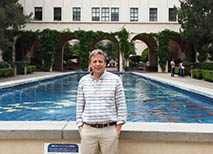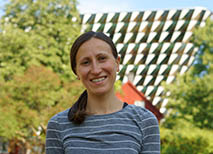Dr Andres Collazo
Director of the Biological Imaging Facility The overarching goal of my research program is to push the limits of optical microscopy to study how proteins function in as close to in vivo conditions as possible. A fascinating area of biology is the study of single protein molecule dynamics in living animals, a potentially powerful means of identifying abnormal protein function and understanding molecular causes of medical disorders. Fluorescence fluctuation spectroscopy (FFS) encompasses several techniques, including fluorescence correlation spectroscopy (FCS) and photon counting histograms (PCH), which provide quantitative data on the dynamics of single protein molecules in living cells (SLAUGHTER et al. 2007; SLAUGHTER AND LI 2010). These techniques detect fluorescence intensity fluctuations as labeled molecules pass in and out of a small confocal volume (<1 femtoliter), created by focusing a low intensity laser. FCS can determine the mobility and concentration of fluorescently labeled proteins (HAUSTEIN AND SCHWILLE 2008; RIES et al. 2009; SCHWILLE AND RIES 2011). Only rarely have these techniques been applied in vivo to multicellular animals (RIES et al. 2009; YU et al. 2009). We have used FCS in living zebrafish embryos to show that changes in α-catenin mobility during development of the pharyngeal pouch reflects the adherens junction remodeling underlying pouch formation (CHOE et al. 2013). Bachelors of Science in Biology from Cornell University, Ph.D in Zoology from the University of California at Berkeley.
Contact Info Office: 626-395-2761
BIF: 626-395-2863
acollazo at caltech.edu
Dr Giada Spigolon
Microscopy Technician Following my graduate training in
the field of Neuroendocrinology, I continued my research in
Neuroscience with a PhD in Molecular Medicine focusing on the
identification of the neural mechanisms occurring in several
neurodegenerative conditions (University of Turin, Italy). I pursued
my postdoctoral research at Karolinska Institute in Sweden, where I
worked on the identification of molecular pathways in striatal
neurons involved in levodopa-induced dyskinesia in Parkinson’s
disease.
During this time I became fascinated by the development of imaging
methods enabling in-depth investigations and new insights in the
field of neurobiology. In the past few years I have trained and
practiced extensively in microscopy methods, in particular using
ZEISS systems to acquire confocal images. I am excited to be part of
the imaging facility and looking forward to contributing to the
vibrant and stimulating community at Caltech..
Contact Info BIF: 626-395-2863
giadas at caltech.edu




